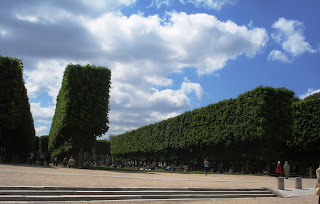The late-great Flann O’Brien (aka Brian O'Nolan, aka Myles na Gopaleen) would, I feel have approved wholeheartedly of Anne Fadiman and her family. The idiosyncratic exponent of the art of Professional Book Handling (http://chriscross-thebooktrunk.blogspot.co.uk/2012/05/i-want-to-be-book-handler.html) would have been delighted by their belief that books are there to be read and enjoyed, and that it is quite right for them to look battered and well-used, because the content is more important than the book itself.
Anne’s family, as revealed in Ex Libris, Confessions of a Common Reader, are book handlers par excellence. They leave open books face down on surfaces, break the spines, turn down the corner of pages, underline passages, and write comments in the margins. Anne’s father used to reduce the weight when reading on planes by tearing pages out as he read them, while her young son eats books.
The book is a beautifully crafted collection of essays on books, reading, language and writing, all originally written for the author’s Ex Libris column in the American magazine, Civilization. And it refutes my theory that one should never believe a book blurb, because it really is ‘witty, enchanting and supremely well written’ – just as The Observer’s Robert McCrum says.
Fadiman, who is both literary and literate, covers a range of topics. I had huge sympathy for the difficulties outlined in Marrying Libraries, which discusses the problems of merging your book shelves when you set up home with your partner. Do you discard duplicates, and if so which copy do you keep? And if each of you has a different system of storing books do you opt for volumes stacked in categories (Anne) or a miscellaneous jumble (her husband)? I’ve been through this: last summer, after nearly 30 years together, The Man of the House have a lot of sympathy ... after nearly 30 years together, the Man of the House and I culled our books and tried to establish a joint ‘library’, with all the fiction together, in alphabetical order, irrespective of genre, but I am still not happy about the shelf full of Sharpe novels which has appeared in the middle of my classics. On the other hand, he questions whether Discworld, Harry Potter and all my childhood books need to be on general display.
 |
| Share and share alike: The nice neat row of Bernard Cornwell's Sharpe novels belongs to to the Man of the House. My novels are shoved in wherever I can find a space. |
I particularly liked My Odd Shelf, though I cannot agree with Fadiman’s assumption that most people have an ‘odd shelf’ full of books unrelated to the main collection. On the whole, people I know are like me, and every shelf is an odd mish-mash! However, Fadiman, who is obviously better organised, has an odd shelf which contains 64 books about polar expeditions, and her comments on Scott’s last journey are very moving.
Anyone who has ever been angered by misplaced apostrophes, double negatives, spelling errors, and other mistakes of that ilk, will love the piece on language (I can’t give the title, because it’s got a printer’s ‘insert’ mark in it, and I can’t reproduce it on the compute, but it’s page 65 in my Penguin edition). Fadiman, her brother, father and mother are pained by such inaccuracies. Fadiman once wrote to Nabokov, listing the misprints in an edition of Speak, Memory; her brother offered to trade a complete list of mistakes in a computer-software manual for an upgraded version of the software; their mother collects newspaper mistakes, intending to send them to the editor, and before he lost his sight her father corrected menu cards, and library books.
 |
| Lost for Words by Johnny Jonas is a Medici Card, which reminds of the Oxfam bookshop where I am a volunteer. |
Secondhand Prose, which discusses the joys of secondhand books is wonderful. Fadiman is the only person I have heard of who was whisked off to such a store as a birthday treat and returned home with a stash of books weighing nineteen pounds. Initially, explains Fadiman, she hunted out used books because she couldn’t afford new ones, but:
... I developed a taste for bindings assembled with thread rather than glue, type set in hot metal rather than by computer, and frontispieces protected by little sheets of tissue paper. I also began to enjoy the sensation of being a little link in a long chain of book owners...
And, as you might expect from someone who loves ‘real’ books so much, she also enjoys writing with a fountain pen and ink, and has some fascinating tales to relate about writing in the essay entitled Eternal Ink. Did you know, for example, that :
One day, when Sir Walter Scott was out hunting, a sentence he had been trying to compose all morning leapt into his head. Before it could fade, he shot a crow, plucked a feather, sharpened the tip, dipped it in crow’s blood, and captured the sentence.
Writing on a computer cannot compete with that! All I can say is that if you love books, you should love this, so please read it - and I've posted this for the Essay Reading Challenge 2012 hosted by Carrie K.















































